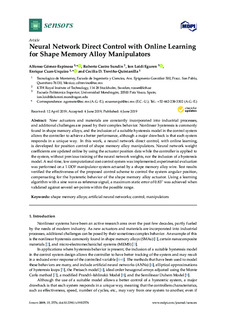
Title
Neural Network Direct Control with Online Learning for Shape Memory Alloy ManipulatorsAuthor
Author (from another institution)
Other institutions
Tecnológico de MonterreyKTH Royal Institute of Technology
Version
Published version
Rights
© 2019 by the authors. Licensee MDPI, Basel, SwitzerlandAccess
Open accessPublisher’s version
https://doi.org/10.3390/s19112576Published at
Sensors Vol.19. N. 11. N. artículo 2576, 2019Publisher
MDPI AGKeywords
shape memory alloysartificial neural network
control
manipulators
Abstract
New actuators and materials are constantly incorporated into industrial processes, and additional challenges are posed by their complex behavior. Nonlinear hysteresis is commonly found in shape memor ... [+]
New actuators and materials are constantly incorporated into industrial processes, and additional challenges are posed by their complex behavior. Nonlinear hysteresis is commonly found in shape memory alloys, and the inclusion of a suitable hysteresis model in the control system allows the controller to achieve a better performance, although a major drawback is that each system responds in a unique way. In this work, a neural network direct control, with online learning, is developed for position control of shape memory alloy manipulators. Neural network weight coefficients are updated online by using the actuator position data while the controller is applied to the system, without previous training of the neural network weights, nor the inclusion of a hysteresis model. A real-time, low computational cost control system was implemented; experimental evaluation was performed on a 1-DOF manipulator system actuated by a shape memory alloy wire. Test results verified the effectiveness of the proposed control scheme to control the system angular position, compensating for the hysteretic behavior of the shape memory alloy actuator. Using a learning algorithm with a sine wave as reference signal, a maximum static error of 0.83º was achieved when validated against several set-points within the possible range. [-]
Collections
- Articles - Engineering [708]
The following license files are associated with this item:





















